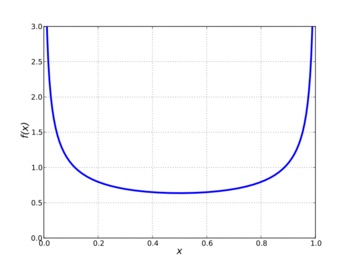Arcsine distribution
|
Probability density function  | |||
|
Cumulative distribution function  | |||
| Parameters | none | ||
|---|---|---|---|
| Support | [math]\displaystyle{ x \in [0,1] }[/math] | ||
| [math]\displaystyle{ f(x) = \frac{1}{\pi\sqrt{x(1-x)}} }[/math] | |||
| CDF | [math]\displaystyle{ F(x) = \frac{2}{\pi}\arcsin\left(\sqrt x \right) }[/math] | ||
| Mean | [math]\displaystyle{ \frac{1}{2} }[/math] | ||
| Median | [math]\displaystyle{ \frac{1}{2} }[/math] | ||
| Mode | [math]\displaystyle{ x \in \{0,1\} }[/math] | ||
| Variance | [math]\displaystyle{ \tfrac{1}{8} }[/math] | ||
| Skewness | [math]\displaystyle{ 0 }[/math] | ||
| Kurtosis | [math]\displaystyle{ -\tfrac{3}{2} }[/math] | ||
| Entropy | [math]\displaystyle{ \ln \tfrac{\pi}{4} }[/math] | ||
| MGF | [math]\displaystyle{ 1 +\sum_{k=1}^{\infty} \left( \prod_{r=0}^{k-1} \frac{2r+1}{2r+2} \right) \frac{t^k}{k!} }[/math] | ||
| CF | [math]\displaystyle{ {}_1F_1(\tfrac{1}{2}; 1; i\,t)\ }[/math] | ||
In probability theory, the arcsine distribution is the probability distribution whose cumulative distribution function involves the arcsine and the square root:
- [math]\displaystyle{ F(x) = \frac{2}{\pi}\arcsin\left(\sqrt x\right)=\frac{\arcsin(2x-1)}{\pi}+\frac{1}{2} }[/math]
for 0 ≤ x ≤ 1, and whose probability density function is
- [math]\displaystyle{ f(x) = \frac{1}{\pi\sqrt{x(1-x)}} }[/math]
on (0, 1). The standard arcsine distribution is a special case of the beta distribution with α = β = 1/2. That is, if [math]\displaystyle{ X }[/math] is an arcsine-distributed random variable, then [math]\displaystyle{ X \sim {\rm Beta}\bigl(\tfrac{1}{2},\tfrac{1}{2}\bigr) }[/math]. By extension, the arcsine distribution is a special case of the Pearson type I distribution.
The arcsine distribution appears in the Lévy arcsine law, in the Erdős arcsine law, and as the Jeffreys prior for the probability of success of a Bernoulli trial.[1][2]
Generalization
| Parameters | [math]\displaystyle{ -\infty \lt a \lt b \lt \infty \, }[/math] | ||
|---|---|---|---|
| Support | [math]\displaystyle{ x \in [a,b] }[/math] | ||
| [math]\displaystyle{ f(x) = \frac{1}{\pi\sqrt{(x-a)(b-x)}} }[/math] | |||
| CDF | [math]\displaystyle{ F(x) = \frac{2}{\pi}\arcsin\left(\sqrt \frac{x-a}{b-a} \right) }[/math] | ||
| Mean | [math]\displaystyle{ \frac{a+b}{2} }[/math] | ||
| Median | [math]\displaystyle{ \frac{a+b}{2} }[/math] | ||
| Mode | [math]\displaystyle{ x \in {a,b} }[/math] | ||
| Variance | [math]\displaystyle{ \tfrac{1}{8}(b-a)^2 }[/math] | ||
| Skewness | [math]\displaystyle{ 0 }[/math] | ||
| Kurtosis | [math]\displaystyle{ -\tfrac{3}{2} }[/math] | ||
Arbitrary bounded support
The distribution can be expanded to include any bounded support from a ≤ x ≤ b by a simple transformation
- [math]\displaystyle{ F(x) = \frac{2}{\pi}\arcsin\left(\sqrt \frac{x-a}{b-a} \right) }[/math]
for a ≤ x ≤ b, and whose probability density function is
- [math]\displaystyle{ f(x) = \frac{1}{\pi\sqrt{(x-a)(b-x)}} }[/math]
on (a, b).
Shape factor
The generalized standard arcsine distribution on (0,1) with probability density function
- [math]\displaystyle{ f(x;\alpha) = \frac{\sin \pi\alpha}{\pi}x^{-\alpha}(1-x)^{\alpha-1} }[/math]
is also a special case of the beta distribution with parameters [math]\displaystyle{ {\rm Beta}(1-\alpha,\alpha) }[/math].
Note that when [math]\displaystyle{ \alpha = \tfrac{1}{2} }[/math] the general arcsine distribution reduces to the standard distribution listed above.
Properties
- Arcsine distribution is closed under translation and scaling by a positive factor
- If [math]\displaystyle{ X \sim {\rm Arcsine}(a,b) \ \text{then } kX+c \sim {\rm Arcsine}(ak+c,bk+c) }[/math]
- The square of an arcsine distribution over (-1, 1) has arcsine distribution over (0, 1)
- If [math]\displaystyle{ X \sim {\rm Arcsine}(-1,1) \ \text{then } X^2 \sim {\rm Arcsine}(0,1) }[/math]
- The coordinates of points uniformly selected on a circle of radius [math]\displaystyle{ r }[/math] centered at the origin (0, 0), have an [math]\displaystyle{ {\rm Arcsine}(-r,r) }[/math] distribution
- For example, if we select a point uniformly on the circumference, [math]\displaystyle{ U \sim {\rm Uniform}(0,2\pi r) }[/math], we have that the point's x coordinate distribution is [math]\displaystyle{ r \cdot \cos(U) \sim {\rm Arcsine}(-r,r) }[/math], and its y coordinate distribution is [math]\displaystyle{ r \cdot \sin(U) \sim {\rm Arcsine}(-r,r) }[/math]
Characteristic function
The characteristic function of the arcsine distribution is a confluent hypergeometric function and given as [math]\displaystyle{ {}_1F_1(\tfrac{1}{2}; 1; i\,t)\ }[/math].
Related distributions
- If U and V are i.i.d uniform (−π,π) random variables, then [math]\displaystyle{ \sin(U) }[/math], [math]\displaystyle{ \sin(2U) }[/math], [math]\displaystyle{ -\cos(2U) }[/math], [math]\displaystyle{ \sin(U+V) }[/math] and [math]\displaystyle{ \sin(U-V) }[/math] all have an [math]\displaystyle{ {\rm Arcsine}(-1,1) }[/math] distribution.
- If [math]\displaystyle{ X }[/math] is the generalized arcsine distribution with shape parameter [math]\displaystyle{ \alpha }[/math] supported on the finite interval [a,b] then [math]\displaystyle{ \frac{X-a}{b-a} \sim {\rm Beta}(1-\alpha,\alpha) \ }[/math]
- If X ~ Cauchy(0, 1) then [math]\displaystyle{ \tfrac{1}{1+X^2} }[/math] has a standard arcsine distribution
References
- ↑ Overturf, Drew; Buchanan, Kristopher; Jensen, Jeffrey; Wheeland, Sara; Huff, Gregory (2017). "Investigation of beamforming patterns from volumetrically distributed phased arrays". MILCOM 2017 - 2017 IEEE Military Communications Conference (MILCOM). pp. 817–822. doi:10.1109/MILCOM.2017.8170756. ISBN 978-1-5386-0595-0.
- ↑ Buchanan, K. et al. (2020). "Null Beamsteering Using Distributed Arrays and Shared Aperture Distributions". IEEE Transactions on Antennas and Propagation 68 (7): 5353-5364. doi:10.1109/TAP.2020.2978887.
Further reading
- Hazewinkel, Michiel, ed. (2001), "Arcsine distribution", Encyclopedia of Mathematics, Springer Science+Business Media B.V. / Kluwer Academic Publishers, ISBN 978-1-55608-010-4, https://www.encyclopediaofmath.org/index.php?title=Main_Page
 |

